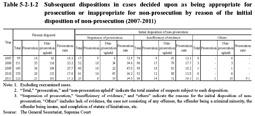3 Appeal system against non-prosecution
The prosecution is in principle exclusively instituted by public prosecutors. However, public prosecutors can make a mistake in deciding not to prosecute a case which in fact should have been prosecuted. Therefore appeal systems against the disposition of non-prosecution by a public prosecutor were established that involved a request for the case to be reviewed by a Committee for Inquest of Prosecution and a request to commit the case to a competent district court for trial (also referred to as the “quasi-prosecution procedure”).
(1) Request for review by a Committee for Inquest of Prosecution
There are currently 165 Committees for Inquest of Prosecution nationwide, each of which consists of 11 members chosen by lottery from the electoral register to serve for a term of six months. Upon receiving a request or as ex officio, the Committee reviews the non-prosecution disposition made by a public prosecutor and then judges whether the case was “appropriate for prosecution,” “inappropriate for non-prosecution,” or “appropriate for non-prosecution.”
Conventionally a decision made by a Committee for Inquest of Prosecution had no legal binding force, and the public prosecutor decided on whether to prosecute the case or not after taking into account the decision of the pertinent Committee. The Act on Committee for Inquest of Prosecution (Act No. 147 of 1948) was then revised (by Act No. 62 of 2004), however, and a system where a prosecution could be instituted based on a decision made by a Committee for Inquest of Prosecution under certain conditions was thereby introduced. Under this system, which came into force on May 21, 2009, when a public prosecutor did not prosecute a case but a Committee for Inquest of Prosecution then decided that the case should have been prosecuted but a public prosecutor subsequently decided not to prosecute the case again or did not prosecute the case within a certain period of time, the Committee for Inquest of Prosecution is then required to reexamine the case. If that then results in the Committee deciding that “the case should be prosecuted” (prosecution decision), the court appoints one attorney (appointed attorney) to prosecute the case and to maintain the prosecution, with the appointed attorney exercising the same function as a public prosecutor in the case.
Table 5-2-1-1 shows the number of persons in cases received and disposed by Committees for Inquest of Prosecution (not including reexamined cases) over the last five years. Of all the persons received in 2011, 1,878 were for penal code offenses. By type of offense, negligence in vehicle driving causing death or injury was the largest in number at 290, followed by abuse of authority at 221, injury at 196, counterfeit of documents at 187, and fraud at 148. 216 persons were received for special act offenses, with Labor Standards Act violations being the largest in number at 60 (all the numbers are totals) (Source: The General Secretariat, Supreme Court).
Table 5-2-1-1 Number of persons received and disposed by Committees for Inquest of Prosecution (2007-2011)
Table 5-2-1-2 shows the subsequent dispositions made by public prosecutors in cases decided upon as being appropriate for prosecution or inappropriate for non-prosecution by reason of the initial disposition of non-prosecution over the last five years.
Table 5-2-1-2 Subsequent dispositions in cases decided upon as being appropriate for prosecution or inappropriate for non-prosecution by reason of the initial disposition of non-prosecution (2007-2011)
From 1949 (after enforcement of the Act on Committee for Inquest of Prosecution) through to 2011, a total of 160,081 persons were disposed by Committees for Inquest of Prosecution, and 17,734 (11.1%) were decided as appropriate for prosecution or inappropriate for non-prosecution. 1,493 were then prosecuted by public prosecutors: 1,334 convicted (468 sentenced to imprisonment and 866 to fine) and 86 found not guilty (including dismissal for judicial bar and dismissal of prosecution) (Source: The General Secretariat, Supreme Court).
The number of persons in cases decided as appropriate for prosecution by a Committee but upheld the disposition of non-prosecution by public prosecutors and a subsequent reexamination by a Committee commenced in 2011 was five, three of which were given the prosecution decision and two of which were not reached to it during the same year (all numbers are totals) (Source: The General Secretariat, Supreme Court).
(2) Request to commit a case to a court for trial
Request to commit a case to a court for trial is a system that enables anyone that filed a criminal complaint or accusation against a case of abuse of authority, etc. committed by public officials, to request a district court to commit the case to a court for trial if they are dissatisfied with the disposition not to institute prosecution made by a public prosecutor. The district court renders a ruling that the case shall be committed to the competent district court for trial if the request is well-grounded. This ruling leads the court to appoint one attorney (appointed attorney) who institutes and maintains the prosecution of the case, exercising the same function as a public prosecutor.
In 2011 the number of persons in cases newly requested to be committed to a court for trial was 162 and the number of persons disposed 162. No decisions to commit a case to a court for trial were made (Source: Annual Report of Judicial Statistics and The General Secretariat, Supreme Court).
From 1949 (after enforcement of the current Code of Criminal Procedure) through to 2011, the number of defendants in cases committed to a court for trial, and the prosecution of which were then deemed to have been instituted and finally judged, was 19. Nine of them were convicted (eight sentenced to imprisonment and one to fine) and 10 found not guilty (including dismissal for judicial bar).

